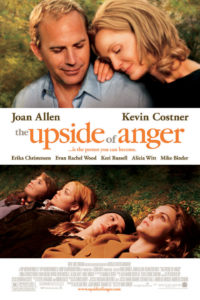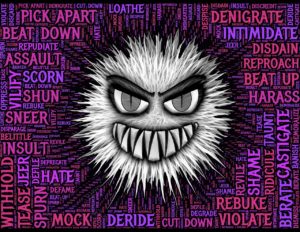In the last two posts, I shared my reflections on anger- how it affects us, the deeper aspects of anger, and how we can use our anger as a powerful catalyst for healing.
A client suggested that if I were to write a part 3- then perhaps I could share about what it feels like to be on the receiving end of someone else’s anger.
I thought this was a brilliant suggestion so here goes!
What does it feel like to be on the receiving end of someone else’s anger?
A movie that comes to mind that illustrates this beautifully is The Upside of Anger- starring Joan Allen and Kevin Costner.

In this movie, the main female protagonist, Terry, portrayed by Joan Allen, is angry- very angry. The sort of anger that simply is relentless. Biting and cutting. Burning all that obstructs its path. Sharp-edged like a sword. Or like multiple daggers slung all at once.
Her youngest daughter, nicknamed ‘Popeye,’ portrayed by Evan Rachel Wood, narrates at the beginning of the movie that anger transformed her mother into a “very sad and bitter woman.” If Terry wasn’t her mother, she’d slap her. She would look her straight in the face and tell her what she really thinks of her…And then run really fast in the opposite direction. ?
But Terry wasn’t always this way. According to Popeye, before becoming so angry, her mother was the sweetest, kindest person anyone could ever now. So, what happened? What is the source of Terry’s anger? Well, it appears that Terry’s husband unexpectedly ran off with his secretary for a holiday rendezvous in Sweden. Or at least that is what Terry believes is the cause of his sudden disappearance. And now Terry is angry. Good and angry, observes Popeye.

A journey through anger
As Terry tunnels through her anger, she takes her family and many others with her. Her youngest daughter, Popeye, and her three other daughters. Their neighbors. Her elder daughters’ boyfriends. And Denny, Terry’s new love interest portrayed by Kevin Costner. They each respond in different ways to her anger as they are affected in different ways. Mostly, the daughters learn to handle their mother’s anger by ignoring her and making their own choices- regardless of her reaction. Hadley, the eldest daughter, chooses to marry her boyfriend after they learn they are pregnant despite Terry’s disapproval. Andrea, the second eldest, decides to pursue a career in radio communications and refuses to attend college- regardless of Terry’s opposition.
One of the daughters, Emily, with a passion for dance, is particularly interesting to me because she is at war with Terry. Emily wants to study dance theory at an academy after high school and become a ballet dancer. Terry dismisses this whole idea as a waste of time and money. Studying dance, scorns Terry, is a way “to live in the clouds” instead of taking “life seriously.” Emily’s way of handling Terry’s and her own anger is a wonderful demonstration of two most common ways we face anger: ·
- At first, Emily engages in an ‘anger battle’ with Terry. She yells, curses, slams doors and rages at her mother.
- Then Emily retreats, and withdraws into herself. Things may seem peaceful on the surface. But the anger volcano is still brewing underneath the ‘psuedopeace.’ Now, the anger is directed inwards- and Emily becomes very ill and needs to be hospitalized in the ICU.
 Emotional space and anger
Emotional space and anger
In my personal experience as well as in coaching clients and observing different relationship dyads- whether they be husband-wife, partners, siblings or even parent-child, there tends to be one who rages outside while the other rages inside. At times, it may not be rage but perhaps irritation or frustration, or even anxiety, depression or sadness that are suppressed. One partner of the dyad takes up the emotional space with anger (or other upsetting emotions like grief, fear or sadness), and will openly express themselves. This leaves less room – or at times no room for the other partner – who will often suppress their emotions. Even if they are also feeling upset or angry. The quiet one may feel a sense of responsibility to ‘keep it together’ for the family. Or feel unsafe to express their emotions because this opens a Pandora’s box that simply can never be closed again. Often, the anger or upsetting emotions – that cannot be expressed towards the partner – are projected onto the body as different physical symptoms.
The mind-body connection
After watching Emily’s illness in the movie, I reflected on some common expressions about anger and how anger can be experienced as illness in the body.
- ‘Swallowing one’s anger’ which can cause resentment, and pain which manifests perhaps as cancer in the esophagus
- Anger that ‘eats away at you on the inside’ showing up in the body as pancreatitis where the pancreatic digestive enzymes begin to ‘digest’ or actually eat away at the pancreatic tissue·
- Feelings of anger which are suppressed manifesting as different chronic pain states (recurrent headaches, or stomach aches)
- ‘Burning up with anger’ which can literally burn a hole inside the gut lining like acid or poison·
- Reaching a breaking point when you ‘explode with anger’- perhaps looking like a sudden spasm of a vessel in the body which manifests as a stroke or heart attack·
- ‘Anger turned inward’ can look like autoimmune diseases where the body literally attacks itself- and the defenses ordinarily used against foreign bacteria or viruses are now used to attack our own tissues·
- Chronic abscesses where there is ‘pus under pressure’- anger is walled off, sealed off, but still there is pain and no lasting relief
Anger is a powerful emotion
Anger is like fire. How does one handle fire?

A toddler or young child cannot be allowed to play with matches, but as they grow older, they can be taught to light a fire, prepare a meal and even burn old refuse and paper in a bonfire. So, we need to find a way to interact with anger that is skillful, firm and clear. When we don’t know how to do that, we do one of the two things- express or suppress. Yet we all probably know from experience that this does not lead to lasting relief or any permanent healing.
The middle way
Here lies the answer to healing. The middle way which my friend David Hoffmeister, a teacher of A Course in Miracles, refers to as the miracle. Here is where we move through the anger. We don’t suppress it. We do find a safe space to express our feelings and frustration – not just to vent – but with the clear purpose to move through the anger- so we can discover the healing beneath.
If we are with someone who is always angry, can we open to see this as an invitation to look at where we are holding anger or upset inside us?
Or where their anger invokes fear inside us and we end up giving our power away?
We of course need to make sure we are safe, and if we ever feel that being with a partner or other relationship could ever cause us any physical or emotional harm, then we need to find a place where we can feel safe. Healing can never occur if we don’t feel physically and emotionally safe.
But, let us say, we do feel safe. Then perhaps we can allow our Inner Wisdom to lead us through the anger to find the gold buried underneath. This is the middle way. This is the path of the miracle- a joining with our Inner Wisdom to allow for healing of our upset. So, we can truly be free.
Perhaps we learn that we are mistaken in our interpretation of the situation; we don’t have all the facts- as Terry learns about her husband’s disappearance (spoiler alert ?). Or perhaps, someone’s anger invites us to engage with our shadow- places where we suppress our own emotional upsets, our anger, our rage behind a mask of being ‘nice’ or the appearance of peace. Maybe the anger in our partner helps us see that we have been out of touch with our own inner power. Somehow, we lost ourselves in the relationship a long time ago and it is time to wake up and take an honest self-inventory. The miracle, or the middle way, is always there for us- even underneath the face of the fire of anger. We just need to be willing to go deeper, join with our Inner Wisdom, and, of course, ask for all the help we need from our mighty companions. ?

Back to the movie…
When Terry finds Emily in the ICU, she faces a turning point. She breaks down crying and sobbing uncontrollably. We clearly see that Terry- like many of us- uses anger as a defense to hide and bury deep hurt and sadness. The movie shares the journey of healing that happens for Terry when she is willing to expose all the pain she is holding underneath her anger. Instead of seeing her daughters, and Denny (her new boyfriend) as the cause of her anger, she begins to see them as the very mighty companions that will help lead her though the anger to the other side.
The upside of anger
Perhaps there is truly an ‘upside’ to anger – if we are willing to allow it to burn away resistance, old patterns and structures in our life that no longer serve. Perhaps the upside to anger can only be discovered if we allow ourselves to take the courage to move through the anger and not be paralyzed by fear of the anger.
I join with each of you reading this in our common purpose to uncover the ‘upside’ of whatever emotional upset you may be experiencing. May our journey be filled with Light and Love!

If you feel inspired to watch the movie, let me know what you discover. Or if you feel inspired to write back with comments, or feedback, I would love to hear as well. You can email me at [email protected] or post your comment on the Coaching for Inner Peace Facebook page.






